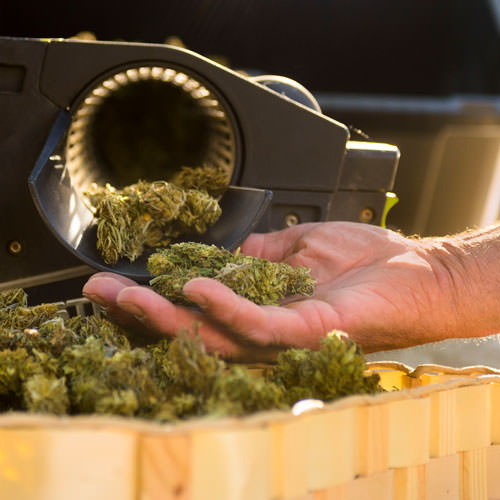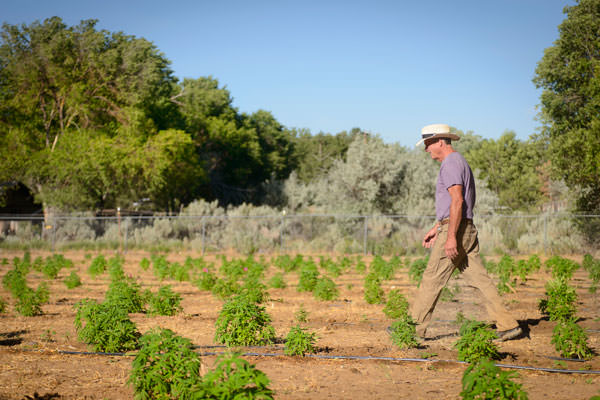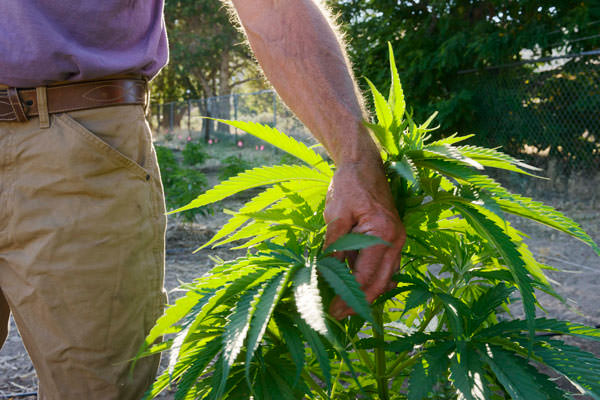The explosive growth of Nevada hemp farms could be the state’s next silver rush.
If there is one crop that requires a farmer to become a biologist, amateur chemist, propagator, wellness advocate, law enthusiast, and public information officer, it’s hemp.
Hemp tends to get lumped into the same group as medical, recreational, and illegal cannabis. While they essentially are all the same plant, the difference between industrial hemp and marijuana comes down to breeding, chemical analysis, and a trained eye. A layperson usually can’t tell the difference between a hemp plant and a marijuana plant, so seeing tall, spiky bushes waving in the wind can send an uninformed passerby to the nearest police station.
Hemp and its notorious cousin, marijuana, both are varieties of the Cannabis sativa L. plant, and both contain the two compounds cannabidiol (CBD) and delta-9-tetrahydrocannabinol (THC). While marijuana can contain up to 30 percent of the psychoactive THC compound, approved industrial hemp contains less than 0.3 percent THC. On the other hand, hemp contains more CBD than marijuana, which is the primary reason for the recent popularity in hemp production.
CBD is a non-intoxicating compound in hemp that is being touted for its medical properties. Last year, the U.S. Food and Drug Administration approved the CBD-based drug Epidiolex to treat two rare forms of epilepsy. Other studies have shown that CBD seems to be effective in treating chronic pain, anxiety, arthritis, and insomnia.

O’Farrell with Sierra Nevada Hemp produces his own topical and smokable CBD products from hemp grown at his Carson City farm
Hemp is not new to Nevada, or to the world. While CBD is getting much of the news, hemp has long been produced for construction material; cellulosic biomass for use in fuel; paper; oil; seed that contains omega-3 and omega-6 fatty acids; and soft, natural fibers. The oldest known artifact of human industry is a 6,000-year-old piece of hemp fabric from Mesopotamia. Even the father of our country, George Washington, grew hemp.
Hemp production has been allowed in Nevada since 2014 under the federal farm bill that legalized research and development of hemp under state department of agriculture supervision. Nevada’s hemp-growing regulations were codified in 2016, and the Nevada Department of Agriculture began to register and certify growers that year. The first growing season was in 2017. In 2018, the federal farm bill fully legalized the production of hemp for states that have USDA-approved hemp programs. Nevada was one of them, and the state’s race to go green is now in full swing.
In 2017, the NDA certified 26 growers utilizing 490 acres and 17,170 square feet of space for hemp. Now, just two years later, Nevada is home to 150 certified growers using 6,778 acres and 1,083,801 square feet of indoor growing space.
“Nevada is on the forefront of hemp growth,” says Ashley Jeppson, administrator of the NDA’s Division of Plant Industry. “This is only California’s first year moving toward certification of hemp farmers, and we have been offering certification of hemp farmers since 2016. Nevada has had an active program for several years and is one of the industry leaders. The industry is booming, and not every state has (an industrial hemp certification) program yet.”
Established and experienced

O’Farrell surveys his crops at Sierra Nevada Hemp
One farmer who has been growing the hotly debated plant for several years as a research crop is Mark O’Farrell of Hungry Mother Organics farm. Through his company, Sierra Nevada Hemp, he grows and produces USDA-certified organic and pharmaceutical-grade hemp containing high amounts of CBD. O’Farrell also produces his own topical and smokable CBD products with his grower and handler licenses.
O’Farrell’s Carson City greenhouse is full of hundreds of hemp plants in seed trays. There’s no overwhelming smell of ganja in the warm space, but the plants do give off a subtle aroma similar to catmint. The plants have lush, serrated leaves and can grow to be more than six feet tall. O’Farrell starts the seeds indoors in March or April and plants them outside after the last spring frost.
“This is a unique growing region, and hemp is one of the few crops that is well suited to it; it grows really well here,” O’Farrell says. “You start them like you would any other seedling. You do have to protect them and nurse them along a little bit when they’re tiny. You have more control indoors and you can grow year round, but our production is primarily outdoors. Hemp has a lot of potential for outdoors, and I have a hard time justifying spending money on electricity when you can grow massive amounts of hemp outdoors in the sunlight.”
Growing outside on a smaller plot of land could send up a green … er … red flag to an uninformed neighborhood. One morning, O’Farrell woke up to find the entire Douglas County narcotics enforcement squad outside his farm. He showed them his growing permit, and after they did a background check and found out he was in compliance, they came back to request that O’Farrell show their department the difference between marijuana and hemp since they receive regular calls from the public about unknown crops.
“They are the same plant; there is no difference other than the different species,” O’Farrell says. “Technically, you can call them cultivars because it’s more of the cultural and breeding practices over time that have created the different plants. It’s just a matter of how they have been bred over time to be CBD or THC dominant.”
He concentrates on growing only female plants for CBD products and actively removes all the male plants. Hemp is a monoecious or hermaphroditic plant that has both male and female reproductive parts and when planted as seed has potential to become either a male or female plant. The size and shape of the pre-flower can tell the farmer whether it is a male or female. Male plants produce pollen, which fertilizes female plants and causes them to produce seeds rather than the large flowers full of resinous buds containing CBD. Seed producers want this, but a farmer focusing on CBD production does not. Many seed companies specialize in feminized seeds that produce only female plants. By being an active participant in each plant’s growth, O’Farrell’s smaller farm can focus on creating a niche for more boutique-style blends coveted by buyers.
“The strains we’re growing all have unique characteristics. They’re like (marijuana) in that they have different terpene profiles, meaning they have different smells and flavors,” he says. “We like cherry wine and other cherry and berry strains that have fruity essences. Chillax has a piney, citrusy smell and flavor.”
O’Farrell adds that the growth potential of the hemp industry is not only in raising crops and producing CBD, but also in the waste. Because of the amount of waste produced by the cannabis industry, figuring out a way to process leftover material could be a lucrative business. O’Farrell found out his farm goats love dried hemp stalks and chomp on them like candy.
While CBD products shouldn’t be treated like human candy, O’Farrell already has found out that his own oils; balms; and pre-rolled, smokable hemp flowers have uplifted several of his longtime customers.
“People tell me that our products help them with arthritis and fibromyalgia,” O’Farrell says. “I’ve never had anyone tell me that our produce changed their life, but I have people tell me all the time that CBD is amazing.”

Mark O’Farrell tends his hemp farm, Sierra Nevada Hemp, in Carson City
Fast company
Like the strains, varieties, and uses, the farmers growing hemp are just as diverse. One farm approaching its second year and second crop of the season is San Hachi Ranch, owned by Caleb and Stacy Kruger. A portion of their 25-acre Minden property is dedicated to growing hemp.
“It’s been really exciting to be in this industry,” Stacy says. “We’ve been trying various seed kits, and we wanted to go more with quality rather than quantity.”
They produce flowers for CBD isolate (which can contain up to 99 percent pure CBD, often come in crystalline or powder form, and can be added to food and drinks) and oil, as well as biofuel. The couple use a hoop house where they mist their seedlings, then move them out into the fields with water emitters in the summer. They plan to test direct field seeding next season.
Even as relative beginners to the hemp industry, the Krugers’ farm still is growing up fast with the help of partnerships. The two have expanded their growing business down to Smith Valley and want to expand to Las Vegas. They currently have a partnership with Fork and Knife Cattle in Carson Valley and Harvest-TEK, a company offering industrial hemp consultation to producers in California and Nevada. Quality partnerships, knowledge, and experience are a quick way to grow a smaller farm into a major industry player, but Caleb offers a warning.
“We’ve been in this for a while, and there are so many people who give you bad advice on how to do things,” he says. “Do your research and don’t partner with people until you understand how everything works, because it’s a hard business and a lot of people will give you the wrong seeds and the wrong advice. Be smart.”
Back to basics
When it comes to partnerships, an ideal situation might be to grow hemp on an established farm known for its beneficial practices and community involvement. Robbie Weisenberg is a first-year hemp farmer growing on Wendy Baroli’s 92-acre GirlFarm, a local farm straddling Washoe County in Nevada and Sierra County in California. He previously worked on a legal cannabis farm in Calaveras County and made the switch to hemp after the county shut down commercial cannabis growing in 2018.
After meeting a group of farmers growing hemp in Pahrump, Weisenberg not only decided to grow the crop, but also to start from the ground up.
“I looked back at history, and when you think of the California Gold Rush, the people who did well were the ones who created the infrastructure,” he says. “With the massive amount of CBD flower hitting the market, it would make more sense to be on the seed-cultivation-and-selling side of the industry. One of the biggest costs is the seed stock, so having certified seed opens the door to being able to do a large project all at once.”
Weisenberg obtained his seed-producer license from the NDA, which allows him to grow viable seed for resale and distribution. Along with seed cultivation, Baroli and Weisenberg plan to produce CBD-infused honey from the farm’s bees.
He’s still in the experimentation phase and intends to plant about 5,500 plants on three acres, as well as grow another 600 plants in a greenhouse while trying to make them flower early. One field will be directly seeded.
Weisenberg is not only excited about seed production, but also the future of hemp products and byproducts. He also is wary of the challenges of growing any kind of crop in the high desert.
“You do have to carry a certain number of spare plants and seeds, and then there are critters, wind, and weather,” he says. “However, that’s just a part of farming. In some sense, it’s like gambling.”
Nevada’s hemp future
What is the financial potential for hemp farms in The Silver State? Could this be our next silver rush? What future challenges does it hold?
“Anyone who is getting into the industry early and puts in the initial investment will probably be OK, but the amount of acreage that is going in now around the Western United States is just enormous, and everyone looks at (the industry) as potentially making a ton of money,” says retired professor Glenn Miller.
Miller is a member of the Department of Natural Resources and Environmental Science at the University of Nevada, Reno and consults with farmers on growing hemp, spacing plants, using water, treating insects, and maximizing CBD production.
“So over the next five years, this is going to be a shakeout time, and the prices will go down,” he says. “You’ll probably still make money if you are good (at growing industrial hemp), but there are going to be a lot of conflicts with neighboring growers who don’t keep their fields clean of pollinating males, and there are going to be a lot of lawsuits. I also think people are going to realize that you can’t grow 200 acres of this stuff without a huge workforce, so there are going to be smaller five- to 10-acre (hemp) farms, which you can still do very well on.”
Christina Nellemann is a Washoe Valley writer who learned a lot about hemp after working on this story. She’s also determined that Hungry Mother Organics’ Wholly Oil warrants a prime spot in her medicine cabinet.
Grow your own?
Rules for growing hemp at home.
Anyone interested in growing hemp should be aware that currently an individual cannot grow the crop as a personal backyard project without a license. To prove that it is not marijuana, each crop (no matter how small) must be registered and certified with the Nevada Department of Agriculture, per federal and state regulations. Registration allows the NDA to track and map where the farm is located, its size in acres, and what type of hemp is being produced.
“Registering with us also allows us to go in, take a sample, and then do a lab analysis and give the farmer back the documentation of its tested level of THC,” says Ashley Jeppson, NDA Division of Plant Industry administrator. “The most important thing for them to do is to look at what is happening with their crops on the THC levels and to maintain that documentation on where they tested to show compliance. When transporting any products, they want to have that lab assessment and certification.”
The NDA offers an initial application and three types of licenses: a grower license, a seed-producer license, and a handler license. The handler license allows a farmer or manager of a facility to receive hemp for processing into commodities, products, or agricultural seed. Each license has its own fee, and each required test must be paid for by the grower or producer.
Fifteen days before a farmer plans to harvest, he or she must also submit a harvest report to the NDA. The report lists the different varieties being planted, and the NDA will take a sample of each variety. The department takes at least 10 randomized cuts of each variety and weighs them to make sure they are equal parts bud and plant. The cuts are then added to a composite sample, which is tested in the in-house lab. If one variety surpasses the allotted 0.3 percent THC level, only that variety of hemp will need to be removed or destroyed.
“We also share information with law enforcement,” Jeppson adds. “We get calls fairly regularly from neighbors reporting that marijuana is being grown, and the nice thing is that we can check our database and the area we’ve personally mapped to prove that they are growing hemp. [We can show] they’ve been tested and verified that it is hemp and they are compliant.”
Security such as fencing is not required by the state, but Jeppson does suggest hanging signs that say the crop is industrial hemp and not marijuana. Signs are a simple way to deter uninformed visitors from jumping fences and stealing crops that might be mistaken for marijuana as well.


